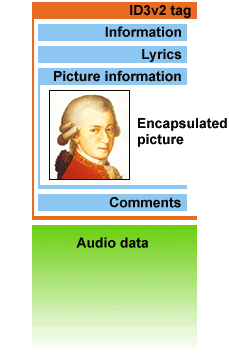Both kinds of information are encoded in a single file. Here is a picture illustrating, at a very high level, this convention for ID3V2 tags (taken from www.id3.org):

Because (in a typical system) a file is just an array of bytes, this means some convention must be followed by the writer of an mp3 file and the reader about which bytes are the tag and which are the encoded audio - that is, there is no "read tags" system call, or anything of that sort. The convention provides the specific information required to interpret the tag data: how to tell where a field (a blue entry in the image) starts and ends, what type of field it is (e.g., artist or track), and how to interpret the data it carries (e.g., artist name as an zero-terminated ASCII string or track number as an unsigned byte).
So far so good. But, most everything about this situation is at odds with the rest of the system, including the underlying file system, which know nothing about the tag convention. Here are two specific examples:
-
File naming
File systems provide "convenient names" using directory hierarchies, leading to hierarchical names with components specified in some specific order; e.g., /usr/include/linux. OF course, mp3 files have these name kinds of names as well, but they're not what the user wants to use. Instead, s/he's more likely to want to say "track 3 of album Where Have All The Merrymakers Gone?" than Harvey Danger/Where Have All The Merrymakers Gone?/Woolly Muffler. In fact, file names are so unnatural/unimportant that mp3 players often basically simply ignore them -- put all your (tagged) files into one directory, with names 1, 2, 3... and that's fine -- the interface between the user and the player uses the tag information, not the file names. - Tag Searching/Editing/etc.
A rich set of tools exists for mainpulating text, e.g., emacs, sed, diff, wc, grep, and on and on. Even though tags are basically text data (or could be thought of that way), none of these tools is directly applicable to the tag information in mp3's. Instead, specialized applications, like tag editors, are required.
There is no good solution at the moment for the second problem. Fixing that is a primary goal of the design exercise.